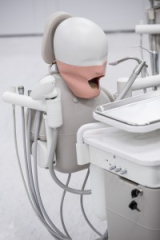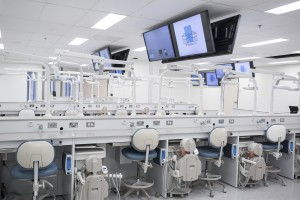From top of the line patient simulators to the latest AV equipment the Simulation Lab is a very progressive learning environment. “When creating this facility, one of the challenges was to anticipate the needs of our students for the next 20 years. I believe that with the simulation lab, the Faculty is meeting this challenge and we will have a great impact on our students training”, says Dr. Jeff Myers Associate Dean Clinical Affairs, of the simulation lab. Equipped with 40 of the most modern, state of the art simulators, the students are able to learn complex clinical procedures, infection control techniques, ergonomics, surgical magnification and other essential elements of operatory management. “Our simulators are as close to the real thing as you can get. Most clinical conditions a student could find themselves in can be replicated right in this room”, says Dr. Sam Abi-Nader. Each simulator has a torso, cheeks, water, suction, hand pieces and controls, creating a real operatory suite setting. The lab is also equipped with more AV materials than your average classroom. Professors can choose between four live camera feeds and a recorded video. Thanks to the multiple double screens placed throughout the classroom, students can see what the professor is broadcasting from any vantage point. “This classroom takes the simulated patient experience to the next level, enabling and facilitating kinaesthetic learning”, says Dr. Sam Malkinson. “In this classroom we have so many ways of relaying messages to our students that we, as teachers, have the challenge of not giving too much information.” A live stream between the simulation lab and an operatory in the undergraduate clinic allows students to watch and interact with a clinician in real time. A dedicated audio line lets students ask questions and interact with the clinician, while a video feed allows them to see the procedure in real time. Students can practice and hone their own techniques within the safety of the lab. The main purpose of the lab is to teach students the essentials of clinical dentistry before they begin working with patients and to ease the transition from theoretical learning to clinical application. It also serves continuing education students that require learning through hands on demonstrations.
Room 222 in numbers
 40 patient simulators equipped with:
40 patient simulators equipped with:
- Head, cheeks and a torso to teach spatial awareness
- The same air turbines, electric hand pieces and controls as the ones found in the undergraduate clinic
- LED operator lights with optional yellow filters to prevent inadvertent curing while placing composites
- Water and suction
4 cameras:
- Instructor camera
- Document camera
- Simulator camera
- Microscope camera
2 suctions systems
- One used during simulated patient exercises
- One with a charcoal filter, used during lab procedures to reduce dust and the spread of volatile compounds
20 TV screens 3 Portable Microscope 4 Portable X-Ray Simulators Kiosks
